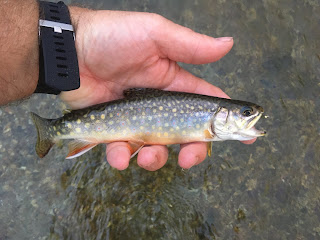Big Spring is a unique limestone spring creek. It is different compared to most of the trout streams anglers fish. All your imperfections as a fly fisherman will show on this stream at any given time. This is not to discourage people from the stream but to let them know this stream is like graduate school to say the least.
Fly Fishing on the Big Spring
Since the closure of the hatchery the fish and fishing have changed. The fish are now extremely spooky and they are extremely selective because of the return of insects (mayflies, caddisflies etc.) The stream is now as clear as gin and the water is deceptively deep in many areas. Spring creeks rely on light as their major energy source so the cover is different on spring creeks (often referred to as chalk streams in Great Britain) than on a freestone stream. The fish will be found in the shadows, at the edge of a weed bed, or sometimes in the open but most anglers will scare these fish and say they can’t find any fish in the stream. The fish are hard to see and appear as ghostly images and just as quickly disappear. Good polarized sunglasses and a practiced eye will aid the angler with a lot of patience. Therefore, the following should help the fly fisherman to get the best out of fishing Big Spring:
Equipment: Rods of 7 .6 to 9 feet work well. Line weights 2, 3 and 4 are the most suited. Leaders of 9 to 12 feet tapering to 3x to 7x depending on the fly being used and the conditions. Limit the number of knots in your leader because they will cause drag in subtle currents and also catch on vegetation in the stream.
Approach: Usually you want to fish upstream on the Spring. The trout are beyond spooky some days and any movement will send them away. Your clothing should not be bright or extremely reflective. Watch the flash of your rod or line. Find the fish first if possible. You are a hunter first on this stream and a fisherman second. If wading, do it carefully with limited motion. In most instances you must be precise in your casting because you may not get many casts and end up spooking the fish.
If you are new to Big Spring a good concept is to take a few hours and just explore the stream using binoculars. You might find some fish feeding or you might be able to watch the fish take-up stations in the stream.
Fly Patterns and Hatches: The stream is still changing as more and more species recolonize the stream however, the Sulfurs (Ephemerella invaria formerly E.rotunda) are the most widely distributed mayflies. They emerge from May to July ( or sometimes later depending on conditions) in sizes 12-18). Blue Winged Olives (Baetis) are on the stream from January through December in sizes 14 to 20. Blue Winged Olives have multiple generations on Big Spring because it’s water temperature remains in very short range 46-50 F. Salt and Pepper Caddis (Hydropsyche and related species) in sizes 14-18 from April through July and Glossosoma Caddis (Little Tan Caddis) size 16 is common. Midges of all colors in sizes 18 to 32 are needed. The Grizzly Bivisible Midge in a size 20-24 is a good bet. Scuds in sizes 12-18 and cress bugs in sizes 12-16 are extremely important. Add a few sculpin streamers and a Letort Hopper, Letort Cricket, Cinnamon and Black Ants,a few colorful beetles and you have a pretty good fly box for Big Spring.

